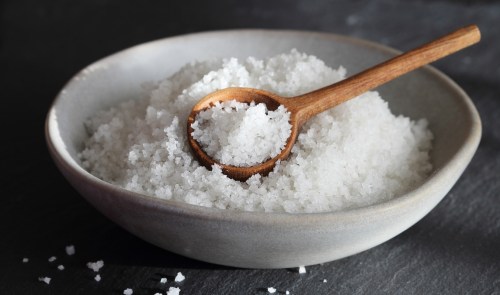Our editors independently select these products. Making a purchase through our links may earn Well+Good a commission
You may have heard health gurus singing praises about Celtic sea salt benefits all over social media as of late. Influencers on social media have been adding Celtic sea salt to their water, claiming it provides a plethora of health perks. With big, bold statements suggesting that the salt can “energize, fight bacterial infection, and aid digestion” on the brand’s website, we had to find out if there’s any truth to these claims.
Experts in This Article
dietitian, speaker, nutrition counselor, author, influencer and nutrition advocate
functional dietitian and speaker based in Hudson, WI
After all, we’re always told to eat less sodium, so can adding another type of salt to our diets actually improve our health? Here’s everything you need to know about whether Celtic sea salt benefits your body, how it compares to other types of salt, and how to use it.
What is Celtic sea salt, and is it the same as Celtic salt?
Celtic (pronounced “Keltic”) Sea Salt is a brand that produces Celtic salt, a specific type of sea salt. Originally sourced from the coastal regions of France, Celtic salt is made by evaporating seawater, leaving behind the mineral-rich salt. Celtic salt is also known as “gray salt” (or sel gris, in French), and it gets its unique color from the minerals found in the clay beds where it’s harvested.
Like all salt, Celtic sea salt is mostly sodium chloride (NaCl), says Katherine Brooking, RD, a dietitian and author. Specifically, Celtic sea salt is about 85 percent sodium—and the rest of it is made up of trace minerals, including calcium, magnesium, and potassium.
Celtic sea salt compared to other salts
Sea salt vs. Celtic sea salt
Celtic sea salt is a type of sea salt (but not all sea salt is Celtic). Both Celtic sea salt and traditional sea salt are made by evaporating seawater. Unlike regular sea salt, which is white, Celtic sea salt is gray and may contain a different mineral content from the clay beds it’s harvested from. Celtic sea salt, and all types of sea salt, are made up of large, flaky crystals.
Iodized table salt vs. Celtic sea salt
Iodized salt is a type of table salt that’s fortified with iodine. Table salt is mined from salt deposits and then processed into a fine texture, a process that removes the small amounts of minerals naturally found in salt, according to the American Heart Association (AHA). After it’s processed, “table salt is then fortified with additives to prevent it from clumping together,” Brooking says. Iodine, a mineral important for thyroid health, is added to iodized salt. However, Celtic sea salt does not contain iodine.
Celtic sea salt grains are larger than regular table salt.
Himalayan pink salt vs. Celtic sea salt
Himalayan pink salt is mined in Pakistan, by the Himalayan mountains. Himalayan pink salt’s higher iron content gives it its signature rosy hue. Like other types of sea salt, including Celtic, Himalayan salt is made up of large, coarse crystals. Himalayan salt also has an earthier taste than Celtic sea salt.
Redmond’s Real Salt vs. Celtic sea salt
Redmond’s Real Salt is an unprocessed salt that comes from seabeds in Utah. This natural sea salt has more iron than Celtic sea salt, and the higher iron content contributes to Redmond’s Real Salt’s light pink color. However, Redmond’s Real Salt may be lower in magnesium and potassium than Celtic sea salt; still, the differences are incredibly minimal.
Kosher salt vs. Celtic sea salt
Kosher salt is another large-crystal salt. Kosher salt undergoes processing, which strips it of any trace minerals it contains. It’s usually not iodized.
Celtic sea salt nutritional facts
A 1/4 teaspoon (the standard serving size) of Celtic Sea Salt contains:
- 0 calories
- 0 g of fat
- 480 mg of sodium (20% DV)
- 0 g carbohydrates
- 0 g protein
The Celtic Sea Salt website doesn’t list the amounts of minerals besides sodium present in the salt, so we don’t know the magnesium, potassium, calcium, and iron content in milligrams.
Celtic sea salt benefits
Most of the purported benefits specific to Celtic sea salt are unsubstantiated by research. Celtic sea salt doesn’t offer any unique benefits that regular salt doesn’t also provide; however, it does contain trace minerals and has a distinct flavor that some people prefer.
Still, the trace minerals like magnesium and calcium found in Celtic sea salt are present in very small amounts, Brooking says. “These minerals aren’t abundant enough to support many of the health claims of Celtic sea salt.”
Let’s break down some of the potential benefits of Celtic sea salt:
1. It can help with hydration if you’re dehydrated
When you sweat a lot—such as during intense endurance exercise or spending time outdoors in very hot weather—you lose a significant amount of sodium. In these scenarios, adding sodium—whether it’s from table salt, Celtic sea salt, or another salt—can help to replenish sodium losses.
“But a mild or moderate workout typically doesn’t require this,” Brooking tells us. For average workouts, plain water, and a balanced diet full of fruit, veggies, healthy carbs, and lean protein are enough to replenish fluid and mineral losses,” she says.
2. It might support skin health
A notable clinical trial in the International Journal of Dermatology1 found soaking in water with sea salt from the Dead Sea for 15 minutes improved the skin barrier as well as skin hydration, roughness, and redness compared to a plain water bath.
The researchers think that the Dead Sea salt’s high magnesium content is responsible for these benefits, so these findings may suggest that using Celtic sea salt in bath water may also help. But these study results are from 2005—and recent research, specifically with Celtic sea salt, is lacking, says Lauren Fleck, RD, a functional dietitian and speaker based in Hudson, WI.
Potential problems with using Celtic sea salt
1. It may contribute to a higher sodium intake
Celtic sea salt has become a staple on social media and is gaining popularity in the wellness space as a healthy alternative to regular salt. But, “this can create a false sense of limitlessness or more-is-better mentality,” Fleck says.
Many of us are already consuming too much salt. The AHA recommends getting no more than 2,300 milligrams of sodium per day, yet most Americans are getting more than 3,300 milligrams every day, according to the CDC. Eating too much sodium can increase your blood pressure and put you at a greater risk for heart disease and stroke.
If you have concerns about salt, “it’s important to consider the sodium content of Celtic sea salt and refined table salt are relatively similar, and Celtic sea salt is not a low-sodium alternative,” Fleck says.
2. It’s not iodized
Iodine is an essential trace mineral that helps make thyroid hormones and contributes to thyroid health. Iodized table salt is one of the simplest ways to meet your iodine needs. But Celtic sea salt (and other specialty salts) doesn’t typically contain any iodine.
According to the National Institutes of Health, people who don’t use iodized salt might be at risk of not getting enough iodine. Iodine deficiency can lead to thyroid dysfunction, mental health, and developmental challenges in children, and birth complications in pregnancy.
Iodized table salt provides over 100 percent of your daily iodine needs in just a half teaspoon, “though it is important to check the label as not all table salt is iodized,” Fleck says. “Iodine can also come from a number of food sources like fish, seaweed, Greek yogurt, milk, and eggs.”
Still, it’s a smart idea to avoid replacing all of the iodized salt in your pantry with Celtic salt—especially if your diet isn’t rich in seafood, dairy, or eggs. “Because table salt is fortified with iodine, an important essential nutrient, it is a good idea to use regular table salt for some of your meals,” Brooking says.
3. It might contain microplastics
Celtic sea salt comes from evaporated seawater, unlike table salt that’s mined and processed. The limited processing involved with sea salts is often a draw for health-conscious consumers as this technique allows more trace minerals, like magnesium, potassium, and zinc, to remain in the salt, Fleck says. “But without the added processing, concerns may rise about what possible contaminants may also remain intact,” she says.
Enter: Microplastics. Contaminated, polluted seawater often contains these microscopic pieces of plastic, which may show up in the sea salt we buy. While our bodies are able to eliminate some microplastics, there isn’t much research around the health implications of taking in too many microplastics, Fleck says.
According to 2023 research in Ecotoxicology and Environmental Safety2, European sea salts only contain a small amount of microplastic contaminants that are well within threshold to be naturally eliminated from the human body. “While it’s deemed safe by current research, it’s worth investigating and following up on future research regarding safety due to changing water quality and emerging research,” Fleck says.
Recommended uses for Celtic sea salt
1. Body scrub
A popular way to use Celtic sea salt outside the kitchen is by making a natural, gentle skin scrub. Simply combine a few tablespoons of sweet almond oil (or another skin-safe oil of your choice) with a half cup of Celtic sea salt for a DIY option, Fleck recommends. Avoid using sea salt scrub on your face as it’s abrasive and might irritate your skin.
2. Bath soak
If your skin is feeling extra rough or dry, try adding one cup of Celtic sea salt to your bathwater next time you’re in the mood for a soak. Remember, the 2005 International Journal of Dermatology study found that a sea salt bath helps improve the skin barrier, skin hydration, roughness, and redness. (As if we needed another excuse to partake in some self-care.)
3. Natural air freshener
Celtic sea salt mixed with dried herbs, dried flowers, and essential oils can be a great way to freshen the air in your home with natural ingredients as a sea salt potpourri, Fleck says.
4. Cooking and baking
Celtic sea salt makes for a great finishing salt; look for recipes with Celtic sea salt. “The unique flavor and granular texture of Celtic sea salt can help enhance sweet, sour, or savory flavors while taming undesirable bitter flavors in your favorite home-cooked dishes,” Fleck says.
For a nutritious side dish, Fleck recommends tossing chopped vegetables in some avocado oil and sprinkling Celtic sea salt on top before roasting them in the oven. “The Celtic sea salt enhances flavors while cutting the vegetables’ bitterness,” Fleck says.
Celtic sea salt is also a great addition to homemade soups and stews. Make your own broth or use a low- or no-sodium-added broth and tailor the flavor to your unique palate by adding Celtic sea salt. (For example, this nutritionist adds Celtic sea salt to make homemade nachos as a remedy for sickness.) Slow-cooking with Celtic sea salt can also enhance the flavors for a rich, flavorful soup, Fleck says.
Here’s another savory idea Fleck recommends trying: Roast your pumpkin seeds at home by tossing them in oil, sprinkling with Celtic sea salt, and roasting them in the oven at 350°F for 10 to 15 minutes for a nutrient-dense snack.
Where to buy Celtic sea salt
FAQs
1. What does Celtic sea salt do for the body?
Celtic sea salt doesn’t do much for the body that regular salt doesn’t. Celtic sea salt may contain more trace minerals than regular table salt, but the minerals aren’t present in significant enough amounts to provide any health benefits.
2. Is Celtic salt better than Himalayan salt?
There’s no evidence that Celtic salt is better than Himalayan salt. Both have similar nutritional profiles, with small differences—Celtic salt contains more calcium and magnesium, while Himalayan salt has more potassium. But these differences are minor, and you can easily get these nutrients from other foods. (That said, Himalayan salt lamps may have some mood-boosting benefits.)
3. What are the side effects of Celtic sea salt?
There aren’t any side effects, unless you eat too much sodium—Celtic sea salt or not. Eating too much sodium (regardless of the type of salt it comes from) can contribute to high blood pressure and increase your risk of heart disease and stroke.
4. How much Celtic salt should I put in my water?
A pinch should be enough. When you’re dehydrated, adding a pinch (about 1/18 of a teaspoon) of salt to your glass of water can help replenish lost electrolytes and rehydrate you. But it’s worth noting that most people consume more sodium than required every day, so adding salt to your water isn’t usually necessary (unless you’re truly dehydrated).
5. Why is Celtic salt so expensive?
Celtic sea salt is more expensive than other types of salts because of its traditional harvesting process and because it isn’t mass-produced.
6. How to use Celtic salt for weight loss?
There’s no scientific evidence that suggests Celtic salt can help people lose weight.
7. Does Celtic Sea Salt cause water retention?
Eating too much sodium, whether it’s from Celtic salt or another type of salt, can cause water retention and bloating.
8. Does Celtic salt alkalize the body?
No, Celtic sea salt does not alkalize the body. The concept of “alkalizing the body” is a myth. The body tightly regulates blood pH between 7.35 and 7.45, and what you eat does not significantly impact your blood pH.
9. Does Celtic salt detox your body?
No, as the concept of “detoxing” your body isn’t rooted in science. Your kidneys filter waste from your blood and do all the detoxing your body needs.
10. What is the purest Celtic salt?
To make sure your Celtic salt is pure, buy from a brand that tests the salt for heavy metals, such as mercury and lead. Selina Naturally, the main brand that produces Celtic salt, is a quality option as it publishes its heavy metal tests results online.
11. Is Celtic sea salt or Himalayan salt better for you?
Both are nutritionally similar and provide about the same amount of sodium. The two salts differ a bit in mineral content. Celtic salt has more calcium and magnesium, while Himalayan salt has more potassium but these differences are so minimal that they don’t impact health.
Proksch, Ehrhardt et al. “Bathing in a magnesium-rich Dead Sea salt solution improves skin barrier function, enhances skin hydration, and reduces inflammation in atopic dry skin.” International journal of dermatology vol. 44,2 (2005): 151-7. doi:10.1111/j.1365-4632.2005.02079.x
↩︎Thiele, Christina J et al. “Microplastics in European sea salts – An example of exposure through consumer choice and of interstudy methodological discrepancies.” Ecotoxicology and environmental safety vol. 255 (2023): 114782. doi:10.1016/j.ecoenv.2023.114782
↩︎
Sign Up for Our Daily Newsletter
Get all the latest in wellness, trends, food, fitness, beauty, and more delivered right to your inbox.
Got it, you've been added to our email list.










